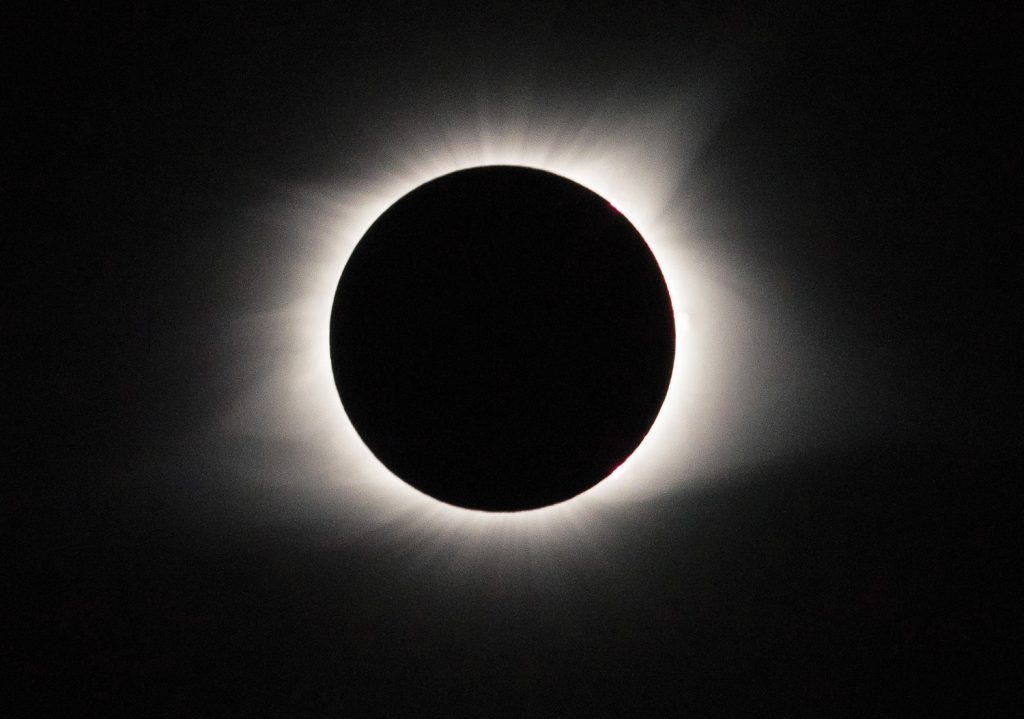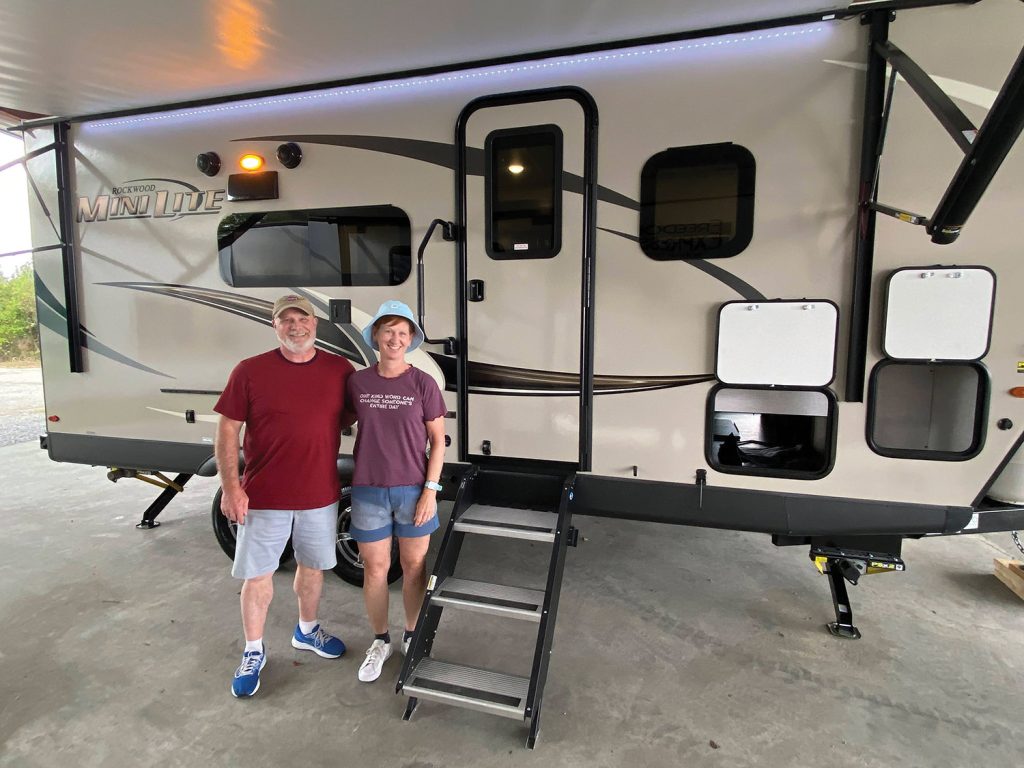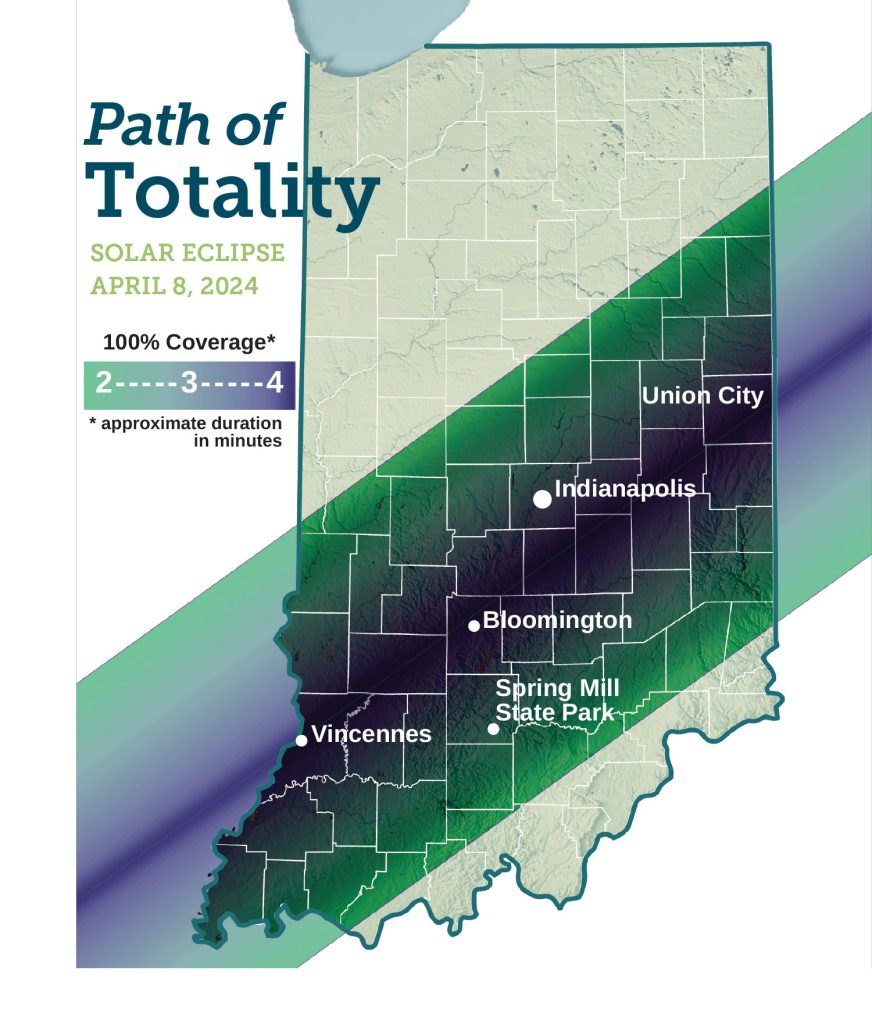
By Richard G. Biever
Last October, Tim and Heather Jarboe booked a campsite at Spring Mill State Park. The dates, April 5-9, are not primo times for catching even blooming redbuds and dogwoods in Indiana. But the couple from Athens, Georgia, is coming for a different display of nature. They reserved their front-row seat to the “Great North American Eclipse.”
The total solar eclipse April 8 will be viewable across more than half of Indiana, weather permitting. Its narrow “zone of totality” is centered on a line running northeast through Indiana from Vincennes to Union City. The zone extends about 50 miles to either side. Totality arrives just after 3 p.m. Eastern Time. Totality, when the moon covers the entire sun and the sky darkens like nightfall, will last around 4 minutes in the center of the zone and lessen the farther to the fringe of the zone.
The Jarboes’ trip was kindled by Tim’s first rendezvous with a total eclipse in 2017, the last one to cross the United States. Its path of totality, which went just south of Indiana, passed through northern Georgia. He took off work to see it; Heather, a school counselor in Athens, was needed as students viewed the partial eclipse and couldn’t join him.

“That was an experience that made me want to come to Indiana for this one,” Tim said. “It’s so amazing when the lights totally go out like that. The frogs start bellowing. Bats are flying. All the nighttime mob gets active because they don’t understand. We wanted to make sure we both saw it this time.”
The two will not be alone in their pilgrimage to the zone. The rare celestial event will bring an influx estimated to be between several hundred thousand to as many as a million people to Indiana alone.
Everywhere along the path, from the west coast of Mexico to Texas to Indiana to Maine to the Canadian Maritimes, communities will be leaping and hopping on this moon shadow. Gatherings and festivals have been in the planning stages for a year or more. Music, food, and programs with special guests and speakers will all be part of a holiday-like celebration surrounding the brief but awe-inspiring show.
Vincennes will be among the first of Indiana’s cities to fall under the umbra, the moon’s darkest shadow, and is smack dab on the center line of that sweet zone of totality. Because of that, Vincennes will experience the longest totality in the state at 4 minutes and 5 seconds.
“The path goes right over the Lincoln Bridge that crosses the Wabash River,” said Sarah Wolfe, director of eclipse activities for Vincennes and Knox County. “It’s amazing. It’s like the universe handed us this little prize.”
“This cosmic alignment is unique,” noted Dan McGlaun, an “umbraphile” and eclipse aficionado from rural Hendricks County. He’s traveled the world to see 15 total eclipses since seeing his first one in 1991. “People should make sure they experience this because they will remember it. Little kids should write down their experience and put it in a time capsule. Then, 50 years from now, when they watch another eclipse with their grandkids, they can pull that out and remember.”
An experience to remember
A total solar eclipse occurs when the moon passes between the sun and Earth, blocking the sun’s light and shadowing part of our planet. It happens about once every 18 months. The narrow band of totality is usually around 9,000 miles long but only about 100 miles wide. So, while a total solar eclipse may occur every couple of years, a single given spot experiences totality just about once every 375 years.
Though this is the second total eclipse in seven years to have arched across the U.S. and garnered massive media attention, folks shouldn’t get used to them. After April 8, the next solar eclipse over the contiguous United States won’t be until 2044, and it will only be over parts of North Dakota and Montana.
Meanwhile, this will be the first total eclipse visible anywhere in Indiana since Aug. 7, 1869. Indiana’s next time in the spotlight of totality, or deepest shadow, won’t be until Sept. 14, 2099.
For Earthlings to even experience the sublime perfection of a total eclipse is a cosmic coincidence — or, maybe, a wink and a nod from God. Consider the odds: The sun’s diameter is about 400 times larger than Earth’s moon, and the sun just happens to be about 400 times farther away from Earth than the moon. That makes the sun and moon appear to be the same size in our sky. When they align, it’s so precise that the moon blocks all the sun’s direct rays for just a few fleeting minutes. Yet, the moon’s still small enough to let us see the sun’s corona, that rarefied gaseous, ghostly glow we would never see otherwise.
Since the 2017 eclipse, McGlaun has parlayed his vast expertise gained over the years by chasing eclipses around the world and learning from other experts into a full-time job. A Purdue-trained mathematician and computer scientist, he’s been a technical projects manager, school teacher, and private tutor. His Eclipse2017.org web page received a web-crashing 10 million hits a day leading up to that eclipse. His updated Eclipse2024.org site continues as a veritable smorgasbord of everything anyone would ever want or need to know about the eclipse and how to view it safely.
A unique feature on his site is a simulator, created from his own computations, that will accurately depict how the eclipse will appear in the sky from first contact, partial stages, totality, and then the passing out of partial for 140,000 locations along the path of totality. The entire eclipse sequence is animated in either real-time or can be sped up.
Something amazing
Though McGlaun is speaking at a big eclipse event in Texas on April 7, he’s planning to fly home to experience this one from his own yard with family and friends. For months and years, he’s been enthusiastically traveling around Indiana and elsewhere talking about this day and what it means.
One of his main messages is: Get to the zone of totality. Even though the moon will cover 90% or more of the sun’s surface in those areas of Indiana outside the zone of totality, even a crescent of sunlight makes a night-and-day difference in the
overall experience.
McGlaun’s given over 100 presentations to schools, civic groups, planning and tourism commissions, and the like, encouraging folks not just to witness this one but also to welcome visitors and celebrate this special event. “You’re sharing something really amazing with so many other people,” he said.
“There is a tremendous amount of buzz surrounding the total solar eclipse,” noted Amy Howell, vice president of tourism, marketing, and communications for the Indiana Destination Development Corporation, the state tourism office. She said the office is working with local, state, and federal officials to make sure communities and businesses will be able to meet the needs of the crowds the eclipse is expected to bring. “We are currently finalizing a checklist with the Indiana Department of Homeland Security,” she said. “IDHS is on it, and talking trash, traffic, toilets, and so
much more.”
Along the path, communities will be hosting special events with music, and food and highlighting what makes each special. Some events in well-known outdoor venues include:
• The Indianapolis Motor Speedway, which is partnering with NASA and Purdue University for an eclipse viewing event at the famed track. NASA will broadcast live, with experts sharing insights.
• Multiple Boone County locations are encouraging folks to “Get Mooned in Boone” with a wide range of family-friendly events.
• The University of Southern Indiana in Evansville is hosting Solarpalooza, a multi-day event that will include a retired NASA astronaut, a full day of experiential learning, and more.
• Indiana University in Bloomington is opening its football stadium as a gathering location. Even “Star Trek” star William Shatner, Capt. James T. Kirk, himself, will be beaming himself down, as part of the star-studded celebration. Mae Jemison, the first African American female astronaut will also be a guest. Like most schools in the zone, IU has canceled all in-person classes April 8.
In addition, the IU Center for Rural Engagement awarded 30 rural organizations across 22 counties micro-grants of up to $2,000 to host arts, education, and cultural activities connected with the eclipse. The funding was provided through the Simons Foundation, a New York City-based organization advancing research in mathematics and
basic sciences.
While gazing to the heavens may seem contrary to bringing people closer, Wolfe, at Vincennes and Knox County, noted that notion is what attracted her to the role as the eclipse activities planner a year ago.
“Professionally, I’m an artist,” she said. “When I heard about this job, there were many aspects that I found fascinating. I love the community engagement and the opportunities that the eclipse offers. I love data and logistics,” she said. “But more than anything, I truly feel that this eclipse is an opportunity for all of us to reconnect to our humanity and heal divisions that we’ve experienced. We’ve been forced apart so many times over the last four years. Here, we’ve got an opportunity to enjoy an awe-inspiring celestial event we get to experience together.”
Special places and people
The most common question McGlaun is asked concerns the weather. While a total solar eclipse can be plotted to the day, hour, and location for centuries, the weather forecast for the next is not as predictable. On average, April 8 in Indiana is often cloudy. But April 8, 2023, provided “glorious” weather.
“Your eclipse day is going to be what it is,” McGlaun said. “If you are around people who are special to you in a place that is special to you, that is your story.”
He said getting to another location is much easier if you start in a rural spot away from traffic jams that are expected in congested areas. “But that’s part of your experience. It’s part of what happens. Sometimes you can do something about it, and sometimes you can’t. It is a true and God-honest metaphor for life: You get the hand you’re dealt, and you play.”
For the Jarboes, Spring Mill fits McGlaun’s criteria. The now-retired couple met at Indiana University. He was from Tell City; she was from North Carolina. Their extended trip north will also include visiting his family in Perry County, just south of the zone of totality, and old college friends near Indianapolis and in Ohio.
“I can remember going to Spring Mill with my family when I was little,” said Tim, who earned his teaching degree from IU and taught elementary school in Bloomington after graduation. “One of the first field trips I ever took students on was to Spring Mill State Park,” he added. “So, it’s cool to go up there for the eclipse to the park where I started my career.” Soon after he and Heather married in 1985, they moved to Georgia where they established long careers in education.
For the Jarboes, visiting family and friends will mean a cloudy day on April 8 won’t make the trip all for naught. Plus, Tim is looking to even the bright side of a cloudy eclipse day. “Even if it’s cloudy, it’ll still get dark. That’s one of the neat things about being in the zone of totality,” he said. “Now, we might not see the corona of the sun, but we’ll experience the environment when suddenly every living thing says, ‘It’s time to wake up and start doing nocturnal things.’ You’re still going to have some of that experience. It’ll be an incredible event to be part of no matter what.”
“We wouldn’t miss it,” Heather quipped, “for the moon and the stars.”
Richard G. Biever is the recently retired senior editor of Indiana Connection.
Make eye safety your priority
Seeing a total eclipse can be a profound once-in-a-lifetime event. But make sure it’s not the last thing you ever see by following these viewing tips.
• hen watching the partial phases of the solar eclipse with your eyes, you must always look through safe solar viewing glasses (“eclipse glasses”) or a safe handheld solar viewer. No matter how dark, sunglasses are not safe. Safe solar viewers must comply with the ISO 12312-2 international standard.
• lways inspect your eclipse glasses before use; discard the device if torn, scratched, or otherwise damaged. Always supervise children using solar viewers.
• f you usually wear eyeglasses, put your eclipse glasses on over them.
• When the moon completely blocks the sun during totality, it is safe to look directly at the eclipse without specialized eye protection. If you watch the eclipse with viewing glasses, it’s safe to remove them when the sun totally disappears. You must put them back on the first instant the sun reappears after totality.
• If you don’t have eclipse glasses, turn to the below websites for tips on indirect viewing methods.
• Do not use eclipse glasses or handheld viewers with cameras, binoculars, or telescopes. Those optical devices require a different kind of solar filter made for their concentrated magnification.
• Avoid ordering eclipse glasses from Amazon or other online marketplaces not listed as an endorsed vendor by the American Astronomical Society. Fake eclipse viewers sold online may claim to be ISO certified but are not, which can be dangerous for your eyes.
For more information
Please visit these websites:
• eclipse.aas.org
• eclipse.iu.edu
• eclipse.gsfc.nasa.gov/eclipse.html
• eclipse2024.org
• in.gov/dnr/places-to-go/events/024-solar-eclipse
• purdue.edu/home/total-solar-eclipse/
• visitindiana.com/eclipse2024
Last minute tips gleaned from McGlaun
Dan McGlaun has traveled the world to witness 15 total solar eclipses in the past 33 years. Only one attempt, in China, was “monsooned out.” Visit his website, Eclipse2024.org, to prepare for how to view the eclipse safely, what you will see, and when. Here, McGlaun offers two final fine points to keep in mind.
The weather: Sadly, the long-anticipated day can be spoiled by the weather. McGlaun suggests that if it’s overcast and raining, have a Plan B. Try to get as far out from under the weather while staying within the zone of totality. He said that’s why Indianapolis is a great place to plan to see it. Indy is a hub intersecting Interstates 65, 69, 70, and 74, plus it has multilane U.S. and state highways also spoking out in all directions.
If the weather is “iffy,” with puffy cumulus clouds, he said keep an eye out as the time of totality approaches. During 2017’s eclipse, he decided to bug out at the last minute as one huge cloud approached.
“We ran five or six miles south to outrun that cloud and made it just in time for totality to start. If you need to relocate, there are plenty of places and ways to do it. Just make sure you do it safely. Don’t stop on the side of the road, in the middle, or anything like that.”
Eyes on the prize: Many things will happen in the few fleeting minutes of totality, which will arrive just after 3 p.m. Eastern Time. McGlaun said folks will be tempted to shoot photos and video. Unless you are a professional photographer with the proper lenses and gear, he suggests taking it all in with just your eyes and other senses, unencumbered.
“If you see it, you will be changed. It is a wonderful, spiritual, jaw-dropping, and amazingly terrifying experience. It’s something that we’ve been given the gift to see. And we should take advantage of these gifts. You’re going to be fumbling with stuff, and you’re going to miss out on what you’re supposed to be looking at, which is the most amazing thing you have ever seen. There are apps out there now that are designed to capture it, but I can guarantee you that you won’t capture what you’ve experienced. Look up from your phone and look up to the sky.”




